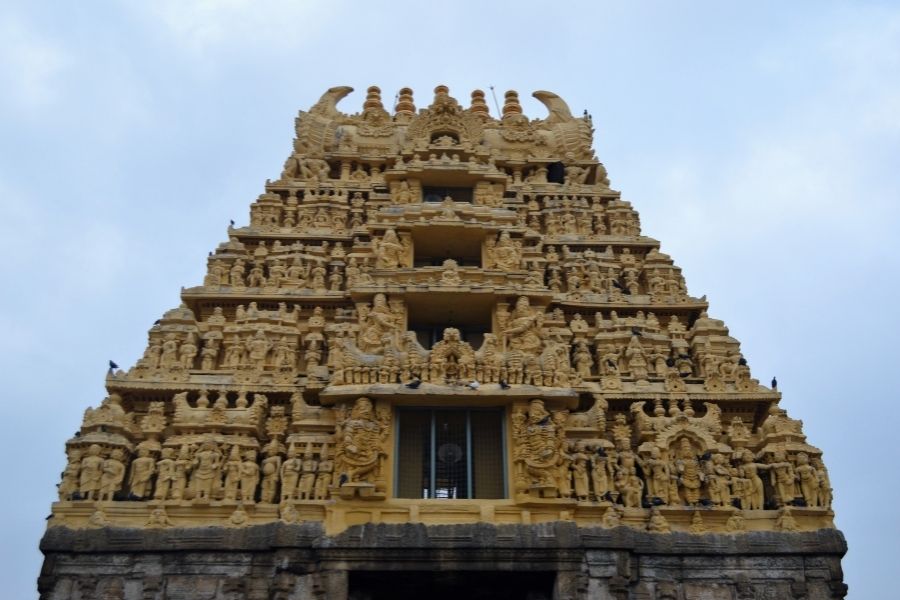Chennakeshava Temple Belur – History, Festivals, How to Reach

The Chennakeshava Temple in Belur, Karnataka, stands as a remarkable example of Hoysala architecture. Dedicated to Lord Vishnu, this temple has stood tall for nearly 900 years, displaying intricate carvings, sculptures, and a rich history that fascinates visitors. The temple is not only a religious site but also a monumental tribute to Indian art and culture.
Let’s explore the marvel that is the Chennakeshava Temple.
1. History of Chennakeshava Temple
Commissioned in 1117 AD by King Vishnuvardhana of the Hoysala dynasty, the temple commemorates his victory over the Cholas in the battle of Talakad. It took over 100 years to complete, involving multiple artisans throughout its construction.
- Dedicated to Lord Vishnu: The temple honors Lord Vishnu, known as Chennakeshava, meaning “handsome Kesava.”
- Hoysala Dynasty’s Legacy: The Hoysalas were patrons of art and culture, and the temple serves as a prime example of their artistic genius.
2. Architectural Brilliance
The Chennakeshava Temple stands out for its distinctive Hoysala architecture, which differs from the Dravidian style prevalent in southern India. Its star-shaped platform, intricate carvings, and detailed sculptures make it a masterpiece.
a. Star-Shaped Platform
The temple sits on a raised star-shaped platform, known as jagati, allowing visitors to admire its exterior carvings.
b. Sculptures
The temple’s exterior features hundreds of intricately carved sculptures, including:
- Hindu Epics: Scenes from the Ramayana, Mahabharata, and Bhagavad Gita adorn the walls.
- Mythical Creatures: Divine figures, musicians, and mythical animals like makaras (crocodile-like creatures) and yalis (lion-like creatures) appear throughout the structure.
- Hoysala Emblem: The emblem of a man slaying a tiger symbolizes Hoysala strength.
Inside the temple lies the Navaranga Hall, supported by polished pillars. Each pillar tells its own story through intricate carvings, including the famed Darpana Sundari or “lady with a mirror.”
d. Ceiling Art
The ceiling features carvings of gods, goddesses, and floral motifs, displaying the craftsmanship of the era.
3. Garbhagriha: Home to the Deity
At the temple’s core, the Garbhagriha houses the idol of Lord Chennakeshava, made of black stone and standing 6 feet tall. The idol’s form is both serene and regal.
- Daily Rituals: The temple remains an active place of worship, with daily prayers and offerings.
4. Pillars of Chennakeshava Temple

Among the many pillars, the Narasimha Pillar stands out, once revolving on its axis. The precision of its construction continues to intrigue visitors today.
5. Other Shrines in the Complex
The Chennakeshava Temple complex includes several smaller shrines, such as:
- Kappe Chennigaraya Temple: Built by Shantaladevi, this temple features another form of Lord Vishnu, Chennigaraya.
- Veeranarayana Temple: Another significant structure within the complex, this temple honors Narayana, a form of Vishnu.
6. Hoysala Craftsmanship
The soapstone used in the temple allowed artisans to create fine carvings and life-like figures.
- Dancers and Musicians: Sculptures of celestial dancers and musicians, carved with delicate jewelry and expressive features, seem almost lifelike.
7. Festivals
Major festivals celebrated at the Chennakeshava Temple include:
- Vijayanagara Festival: This annual event celebrates the temple’s cultural significance through dance, music, and rituals.
- Rathotsava: The grand chariot festival draws large crowds every year.
8. How to Reach Chennakeshava Temple
The temple is well connected to major cities in Karnataka:
- By Road: Belur is about 220 km from Bengaluru and 150 km from Mysuru, with regular bus and taxi services.
- By Train: The nearest railway station is in Hassan, 40 km from Belur.
- By Air: The closest airport is Mangalore International Airport, 160 km away.
9. Best Time to Visit
The best time to visit is between October and March when the weather remains pleasant.
10. Nearby Attractions

Nearby attractions include:
- Halebidu Temples: Located 16 km from Belur, these temples are another example of Hoysala architecture.
- Shravanabelagola: A Jain pilgrimage site famous for its massive statue of Bahubali, 85 km from Belur.
Conclusion
The Chennakeshava Temple offers more than just a place of worship. It’s an architectural masterpiece, a historic landmark, and a cultural treasure. From its intricate sculptures to the star-shaped platform, the temple continues to captivate visitors with its artistic and spiritual significance. Whether you’re an art lover, history enthusiast, or spiritual seeker, the Chennakeshava Temple in Belur stands as a testament to the grandeur of India’s past.


